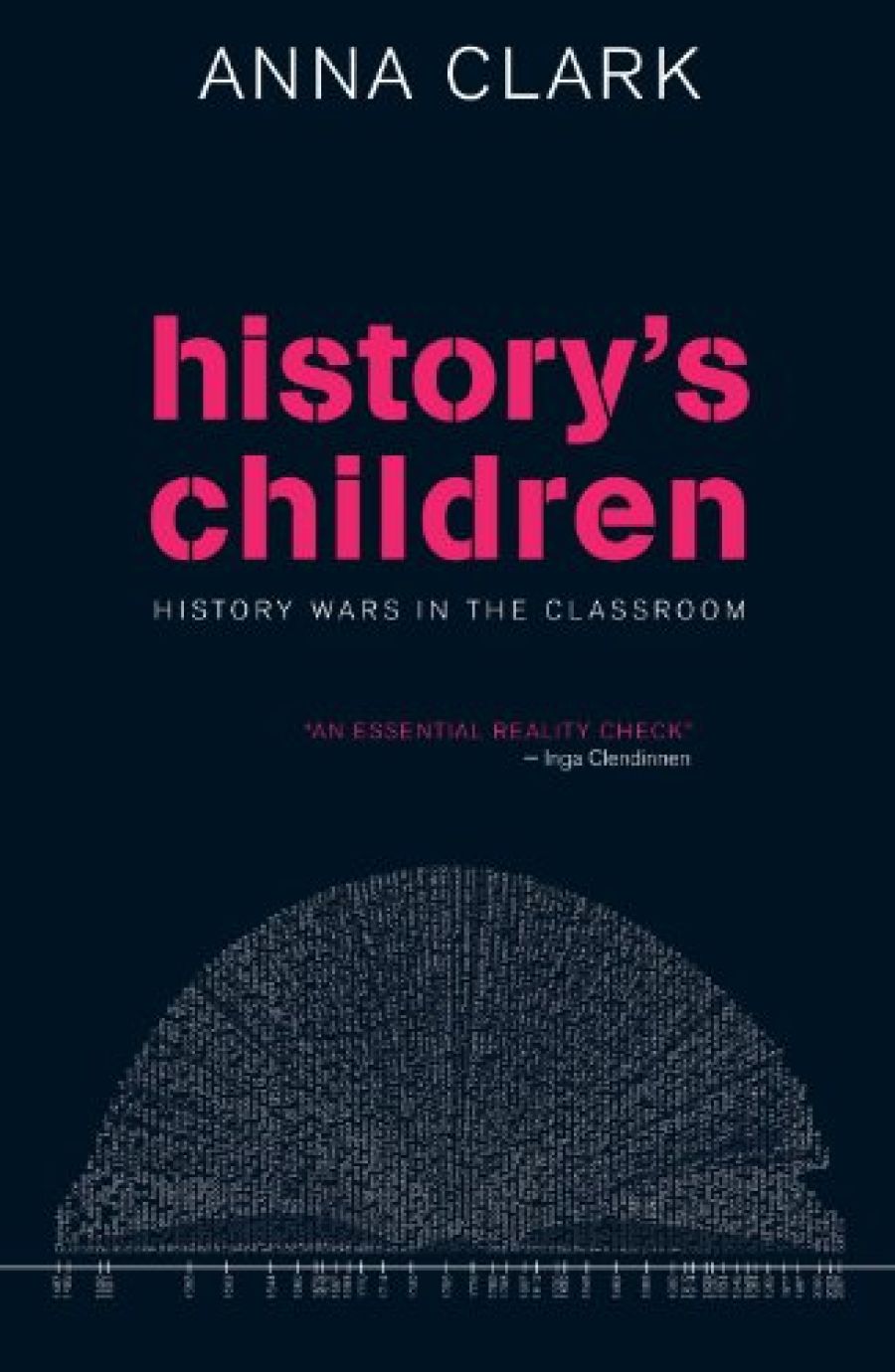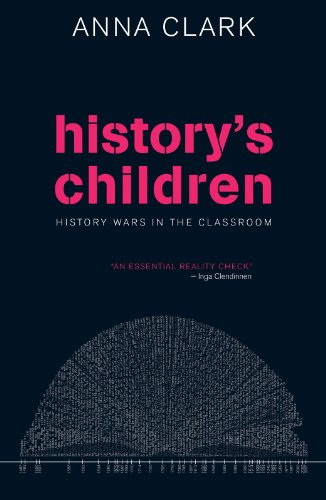
- Free Article: No
- Contents Category: History
- Review Article: Yes
- Article Title: Where we’re at, like
- Online Only: No
- Custom Highlight Text:
This is an honest, modest report of what students and teachers across the country think about the teaching of Australian history in schools. Anna Clark has allowed her subjects to speak for themselves; being a scrupulous historian, she has not edited their offerings. So we hear words like these: ‘Now they’re having like record numbers [at Anzac Day], and like huge ceremonies all over Australia and they’re like young people that respect it’; and ‘Reading a textbook, when you have to like read three pages of a textbook, and then the teacher’s like, “Do the questions”...’ An enduring value of this book will be its record of teenagers’ spoken English in the first decade of the twenty-first century. It makes for rather tiresome reading, but it is salutary to be constantly reminded of where students are at, like.
- Book 1 Title: History’s Children
- Book 1 Subtitle: History Wars in the Classroom
- Book 1 Biblio: NewSouth, $29.95 pb, 178 pp
- Book 1 Cover Small (400 x 600):

- Book 1 Cover (800 x 1200):

We are close to the world of Summer Heights High, as depicted by Chris Lilley. At one school, there are boys outside peering into the room where Anna Clark is examining her focus group. ‘Is she hot?’ one boy asks. In one of the focus groups, there is a veritable Ja’mie giving a magnificent denunciation of the line teachers have been forcing on her in regard to Aborigines: ‘Like we’re meant to feel that our ancestors came and like killed a billion Aborigines and took over a country and gave them diseases. It’s kind of bad enough that we’re the convict country but when it’s drilled into us that we killed everything good in this country, it’s not like fun.’
Students generally are in revolt about the constant offerings on Aboriginal society and history; partly because of their rejection of the guilt-trip that some teachers are inflicting on them, but chiefly because of the constant repetition of material. The book provides new evidence of what a disaster has followed the abandonment of a prescribed curriculum in schools. Teachers outside New South Wales have been free to choose what they will teach to advance historical understanding. Frequently, year after year, they choose the same things. A well-organised school can avoid repetition and ensure some sort of progression in study over the years, but this rarely happens. Until there is a prescribed curriculum, no secondary school can know what its students have studied at primary school.
Though Clark does not mention it, the other turn-off in Aboriginal history is the presentation of Aborigines as noble savages. Bored teenagers would no doubt be very interested in the practice of young women being promised in marriage to old men and how this explains the attraction of some young Aborigines to European society, but to explore this would be regarded as ‘insensitive’ and has no place in the broad, simple story of colonisation and dispossession that some teachers want to present. If this subject were proposed for the curriculum, it would probably be vetoed by an Aboriginal reference group.
Clark finds that students are bored too with the constant offerings on Federation, which no one appears to be able to make interesting. I had the same problem with most university students and wrote The Sentimental Nation: The Making of the Australian Commonwealth (2000) partly in the hope that it would fix this problem – so far without success. Sadly, some teachers seem themselves to have accepted the view that men in suits and beards can’t be interesting. What might not be done with Parkes, three times bankrupt and still premier; the slangy, obese Reid; and the disreputable, radical Kingston?
The third subject whose presentation Clark examines is Australians at war. Here, there is real enthusiasm from the students, both boys and girls, and Clark worries that perhaps the students are too uncritical, accepting the Anzac myth rather than assessing it. In senior school, at Years 11 and 12, students might be ready for a critical examination of myths, but I am not concerned if, in junior and middle school, history is somewhat mythical. The insistence that schoolchildren must themselves be mini-historians may be one of the things that has made history boring. Let students have stories that enlarge their sympathies and exercise their moral sense.
One reason that students enjoy studying Australians at war is that it takes them out of Australia. Clark reports that, generally, students think that it is proper to study Australian history but many prefer other histories where there is more spectacular conflict and drama. One can sympathise with this view and we can cheerfully accommodate it, because, if one of history’s purposes is to teach students about their own society, then they should learn of the civilisation of which Australia is a part. The case for a compulsory study of European and British history is as strong as for compulsory Australian history.
Clark does not do much more than report the findings of her interviews. She records that students find textbooks boring, but she does not examine the books that are in regular use (which make tremendous efforts not to be boring, or not in the old-fashioned way). She mentions the History Summit called by the Howard government, but does not consider its recommendations or the curriculum developed from them by Professor Tony Taylor. She is firmly in favour of a national curriculum, allowing for regional variations, but she gives too much credence to those gormless teachers and officials who consider that for students in remote areas what happened in Sydney may not be ‘relevant’. She concludes that passionate, creative teachers trained in the discipline of history are the keys to success. Certainly, much more attention needs to be given to creating them than to another curriculum document. On this front in the ‘history wars’, I can detect no movement at all.


Comments powered by CComment